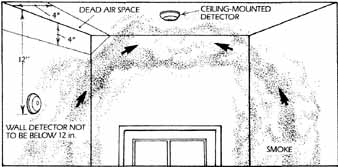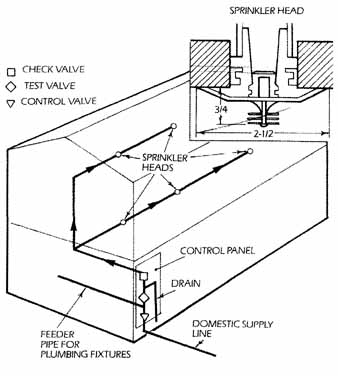Fire Extinguishers
I want to buy a fire extinguisher for my home, but I don’t know which type to get.
This is a good question because using the wrong type of fire extinguisher could do more harm than good. It must suit the type of fire that’s burning.
There are three types of fires. Class A fires are those involving ordinary combustibles such as wood, paper cloth, rubber, and so on. Home fires of this type often start in the living room or bedrooms. Class B fires involve cooking oils, grease, gasoline, paint thinners, and other flammable liquids. These fires generally break out in kitchens and garages. Class C fires are electrical fires, and are usually the result of faulty wiring, overloaded circuits, short circuits, or faulty electrical appliances.
On fire extinguishers, the letters A, B, and C within a triangle, square, and circle designate these categories, respectively. Class B- or BC-rated extinguishers are not effective on a Class A fire. Also, water, which is effective in extinguishing a Class A fire, will cause a Class B fire to spread and can cause a severe shock in a Class C fire. Once a fire in the home spreads, it can quickly include all three categories. Therefore, your best choice is a fire extinguisher rated for all three classes of fire.
Fire extinguishers are available at hardware stores and home centers. When you buy one, check to see that it’s listed by Underwriters Laboratories, Inc., and displays the A, B, and C designations. Also, note the numbers in front of the A and B designations. These refer to the size of fire that the extinguisher can generally handle. The numbers are not absolute figures, but are relative terms for comparing different units. For example, an extinguisher with a rating of 2A:40B:C will handle a Class A fire twice as large, and a Class B fire four times as large, as a unit rated 1A:10B:C.
Letter and Symbol Code on a fire extinguisher: A: For Fires Involving Combustibles Such as Wood, Paper and Cloth; B: For Fires Involving Flammable Liquids Such as Grease, Gasoline and Paint Thinners; C: For Electrical Fires
Note that there are no size ratings for Class C fires. The C designation only means that the chemical inside won’t conduct electricity.
Wood-framing: Clearance Requirements
My house has a heating system with a metal chimney, which runs up through the attic and terminates above the roof. Since the temperature of the chimney in the attic is not high enough to ignite wood, why is it necessary to have a 2-inch clearance between the chimney and the wood framing in the attic?
The ignition temperature of wood is defined as the temperature at which it begins to burn. Wood and other combustibles undergo a physical change when continually exposed to elevated temperatures. This reduces their ignition temperatures.
Wood normally begins to burn at about 400° to 600°F. However, when it’s continually exposed to temperatures between 150° and 250°F, its ignition temperature can be as low as 200°F.
The lowering of the ignition temperature of wood and other combustibles can take years to occur. When it does, should the wood’s temperature coincide with its lowered ignition temperature, it will ignite and burn spontaneously. This is the basis for the clearance requirements in codes.
Fire-extinguisher Service Life
For 35 years I have been very concerned regarding fire protection and therefore I have always kept a variety of fire extinguishers at hand. I regularly check their condition and pressure gauges. Some of the fire extinguishers are 20 years old and have never been used.
When is it advisable to service or discard a fire extinguisher, even though the gauge indicates it’s okay?
Even though the gauge on your old fire extinguisher indicates that the unit is fully charged, you don’t want to find out during a fire that it’s incapable of putting out a fire. Your safest bet, according to Kidde, a manufacturer of fire extinguishers, is to follow the recommendations of the National Fire Protection Association (NFPA).
Residential fire extinguishers come in two types— rechargeable and non-rechargeable. The NFPA recommends that after six years rechargeable extinguishers that use dry chemicals be inspected. Rechargeable extinguishers that use water, carbon dioxide, or foam should be inspected every five years. In both cases, a fire-extinguisher service company should perform the inspection and recharging operations. The inspection should include disassembly and examination of the internal cylinder surface as well as all components. The extinguisher should then be refilled with the appropriate fire-fighting agent, reassembled, and recharged. It’s likely this will cost more than a new unit, which in my opinion is the better option.
Non-rechargeable extinguishers don’t require the six-year internal inspection. However, even if the gauge on the unit indicates that the unit is charged, the extinguisher should be removed from service 12 years after its date of manufacture In addition, all extinguishers should be periodically inspected to see that the unit is unobstructed, that the seal or tamper indicator is not broken, and that there is no evidence of corrosion or other outwardly evident damage. The pressure gauge should indicate that pressure is in the operating range.
Kidde further recommends that extinguishers be inspected monthly for insect infestation. Although this does not seem likely, insects have been known to build nests in extinguisher valves, preventing their proper operation.
Chirping Smoke Detector
I have a problem with my smoke detector chirping. The batteries have been changed, but it doesn’t seem to help. What is the problem and how can I fix it?
As you know, a smoke detector chirping generally indicates that the battery is weak and should be replaced. It will also occur if the battery is not properly installed. Check that the battery is snapped firmly into position. Dirt or dust on the alarm cover can cause chirping also. You can clean the cover by gently brushing a vacuum over it.
If this does not correct the problem, then there is a malfunction in the detector and it should be replaced. If the device is still under warranty contact the manufacturer for a replacement.
Do you have other smoke detectors throughout your home? How old are they? Fire-safety professionals recommend replacing smoke alarms before they are 10 years old. If you are not sure how old they are, play it safe and replace the
Smoke Detector Location
To afford the earliest possible warning in a fire, it’s important that a smoke detector be located properly on a wall or ceiling.
Smoke is lighter than air and rises with convection currents, but not as a stratified layer. Smoke will bounce off the walls as it rises, leaving a dead airspace about 4 inches wide and deep at the corner of the walls and ceiling. A smoke detector placed in the space may not detect smoke until the room is filled with smoke, precluding the possibility of an early warning and a safe escape.

Ceiling-mounted smoke detectors should be mounted outside
the dead airspace. Wall-mounted smoke detectors should be mounted below it,
but not more than 12 inches below the ceiling. Neither wall- nor ceiling-mounted
detectors should be placed near a light fixture or a ventilation grille that
could block smoke from reaching the detector.
Smoke Alarm Signal
My husband and I were awakened recently when all our hardwired smoke detectors went off at once. We checked everything and found no problem. Do you have any idea what causes this?
A smoke alarm can be triggered by a buildup of dust, dirt, or an insect building a nest inside it. To prevent this, gently vacuum a smoke alarm periodically, and change its battery once a year. When smoke alarms are hardwired and one unit is activated, all the others will be activated. The fact that the alarms went off at the same time indicates that they are working properly.
Home Fire Sprinklers
Affordable and dependable sprinkler systems with low-profile heads are available for one- and two-family homes. A sprinkler system combined with smoke detectors provide the most reliable form of residential fire protection for you and your family. Excluding deaths by explosion or flash-fire, there are no known cases of multiple deaths in a fully sprinklered building due to fire or smoke, according to the U.S. Fire Administration. Though 80 % of fire deaths occur in residential buildings, they rarely have sprinklers.
Smoke detectors make a vital contribution to fire protection by providing early warning, but sometimes even this is not enough. About 50 % of the fire death victims were very young or old, handicapped or intoxicated, and were unable to escape.
Residential sprinklers are designed to protect people in the area of fire origin and reduce fire damage. They activate five to seven times faster than standard commercial sprinklers and have a different spray pat tern and droplet size. Their quick response keeps toxic gases and smoke to a minimum.
Also, they prevent fire from growing to the flash-over stage. This occurs when gases from burning materials accumulate and explode. Generally, flash-over takes place when temperature at ceiling level reaches 10000 to 2000° F. With many combustible materials being introduced into homes in construction or as furnishings, the flashpoint can be reached in two to three minutes.
Designers paid special attention to the appearance of the sprinkler head. It projects only about ii in. from the finished ceiling. Many use escutcheon plates that can be painted or plated. The heads thread into feed pipes.

Check Valve; Test Valve; Control Valve; Sprinkler Head
In 1976, less than 5 % of U.S. homes had a smoke detector. Today, most homes have one or more.
Flame Spread
Can you tell me what “Flame Spread 200 or Less” means? I saw it on a label on the back of a 4 x 8 plywood panel that had a decorative finish.
Flame spread is the propagation of a flame over a surface. The flame spread rating classifies the fire hazard potential of different building materials. It’s based on tests performed by independent labs using procedures developed by Underwriters Laboratories. Inorganic materials and untreated red oak provide the range against which flame-spread ratings are made. Inorganic materials, which include concrete, cement-asbestos board and metal, have a flame spread of 0. Untreated red oak has a flame spread of 100.
Building codes require materials that have a low flame-spread rating (0-25) to be used in fire escape routes, such as in stairways and exits. Where passage- ways and corridors are not part of an enclosed exit, the flame-spread rating of the material should not exceed 75. Materials used for interior walls and ceilings generally have a flame-spread classification of 200 or less. This includes most untreated plywood or paneling.
Previous: Home Safety and Health Next: More Fire Prevention Tips